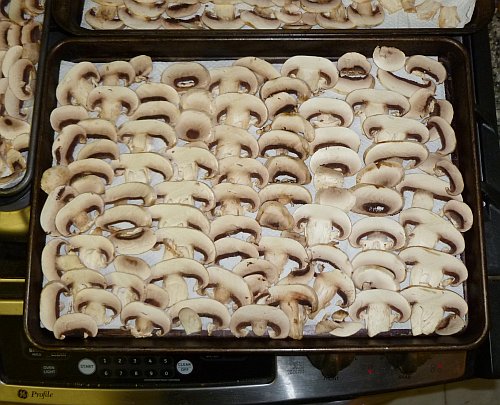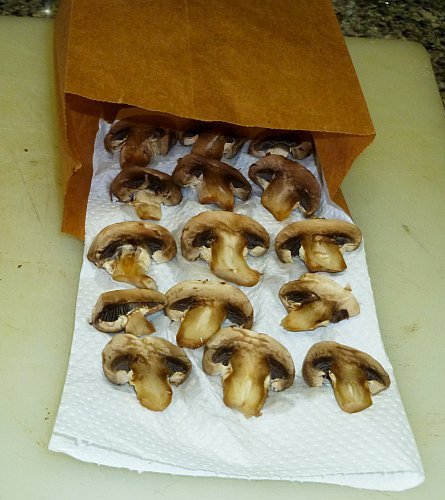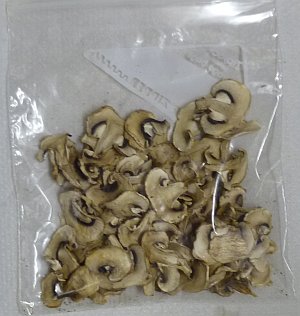 Index
Index

Mushrooms are delicious and nutritious. Most mushrooms sold commercially are grown in controlled, sterilized environments. Cremini, portobello, and white button mushrooms are varieties of Agaricus bisporus. Mushrooms are a good source of B vitamins, such as riboflavin, niacin and pantothenic acid. Mushrooms also contain selenium, copper and potassium, which are essential minerals.
Fresh mushrooms can be kept in the refrigerator for a few days, but dry mushrooms can be kept for many months at room temperature in the pantry. When rehydrated, the dry mushrooms are almost indistinguishable from fresh mushrooms as ingredients of most recipes. Below are the steps for several methods of drying mushrooms.

Clean the mushrooms
Commercial mushrooms often have some clumps of the medium in which they are grown.
Mushrooms collected in the woods often harbor various insects, as well as insect eggs and larvae.
Washing the mushrooms removes dirt and foreign material. After washing,
pat the mushrooms dry with paper towels and allow them to air dry for half an hour before
slicing them.
Some mycophiles adamantly oppose washing mushrooms, and they prefer to just brush them
with a soft brush.
Slice the mushrooms
Prepare a baking tray by lining it with two layers of paper towels.
The towels will absorb any moisture released by the mushrooms and will aid
in evaporating the water. Slicing is the preferred way of preparing fleshy mushrooms like
the commercial Agaricus or wild boletes for drying.
Slice the mushrooms into thin slices no thicker than 1/8 of an inch (2 mm).
The thinner the slices, the faster they will dry.
Place the mushroom slices on the tray, and arrange them so that the cap of
a slice overlaps slightly on the stem of the previous slice. This type of layering
provides an air space under each mushroom slice that increases the surface area
and speeds up the drying. The following picture shows how the mushroom
slices are arranged.
Method 1: Air dry the mushrooms slowly in warm place
If you place the tray with mushrooms in an oven, the mushrooms will release water
very fast and the towels will get damp; you will end up with very bad baked
mushrooms. Drying at low heat is particularly useful for fleshy mushrooms
that have a lot of moisture.
The mushrooms must be dried in a warm, airy place so that the water
released evaporates immediately without wetting the paper towels. This can be done
by turning the oven to 200°F (93°C) and placing the tray with the mushrooms
on top of the stove, NOT inside the oven. Turn off the oven after 30 minutes.
A few hours later, when the oven has cooled, repeat the process of warming the oven
and turning it off. The trays on top of the oven with the mushroom slices get just barely warm to the
touch, but this is enough heat to evaporate the water from the mushrooms without releasing
liquid water. During the drying process, you should turn over any slices that
are too thick and start curling up at the edges.
The drying process may take from 24 to 48 hours. The following picture shows
how much the mushrooms shrink when they dry.
Mushrooms may also be dried in a food dehydrator.
Some people recommend drying the mushrooms INSIDE an oven at a temperature not exceeding 150°F (65°C). After an hour, the mushrooms are blotted with a paper towel to remove any moisture, and turned over. The blotting and turning is repeated every hour until the mushrooms are completely dry.

Method 2: Stringing and sun drying
Mushrooms may also be dried by slicing them as shown above, stringing
them with Cooking Twine,
and then hanging them at home or out in the sun. This method does not use
gas or electricity, but it may take a lot longer than using an oven or dehydrator.
Morels have a large surface area, and they don't need to be sliced.
Morels may be dried in a sunny location by
placing them on window screens supported horizontally above the ground
so that air may circulate freely. Morels dried in this way preserve their
size and shape. Morels dried in a dehydrator will shrink slightly.
When drying mushrooms outdoors, select a spot where birds, squirrels, bugs, and moisture can't get to the mushrooms.
Method 3: Freeze drying
Place whole morels or mushroom slices separated by paper towels in a paper bag in the freezer.
Over time, the mushrooms will lose moisture and dry up because the
paper bag allows water vapor to pass through. You can speed up the process somewhat by
placing an uncovered, paper-lined tray with the slices of mushrooms overnight in the freezer
before transferring the frozen slices to a paper bag. Overnight freezing in an
open tray eliminates a lot of the surface moisture
and prevents the mushroom slices from freezing into an icy clump that will take longer to dehydrate.
Frost-free refrigerators circulate dry air in the freezer compartment using one or more fans.
Air circulation helps to sublimate ice that forms on frozen items.
Sublimation is the process of going directly from the solid phase to the gaseous phase without passing
through an intermediate liquid phase.

Store the dry mushrooms
You will know that the mushrooms are dry when the slices are very light in weight
and they break like a cracker instead of bending when you try to fold them. At this point you
can put them in plastic Ziploc Bags or
jars with air-tight lids.
Do not store mushrooms that are not completely dry because they can get moldy and spoil. If necessary, do the final drying by placing the mushrooms in an oven at 150°F (65°C) for half an hour or until they are cracker dry. Allow them to cool before storing them.

I would like to thank my friend Kurt Rottweiler, an avid mushroom hunter, for his comments and suggestions.